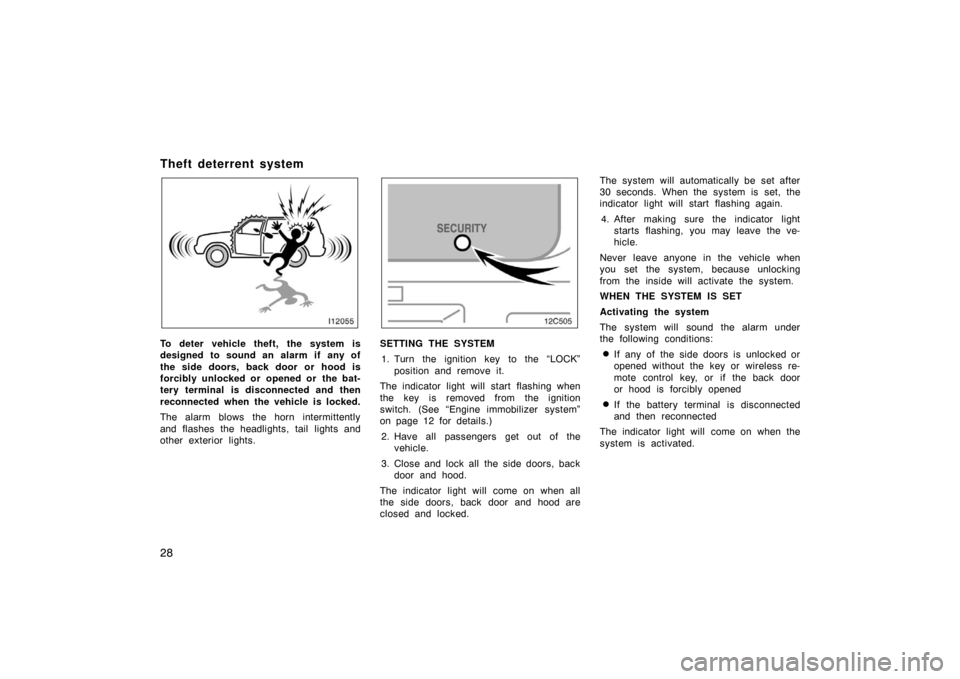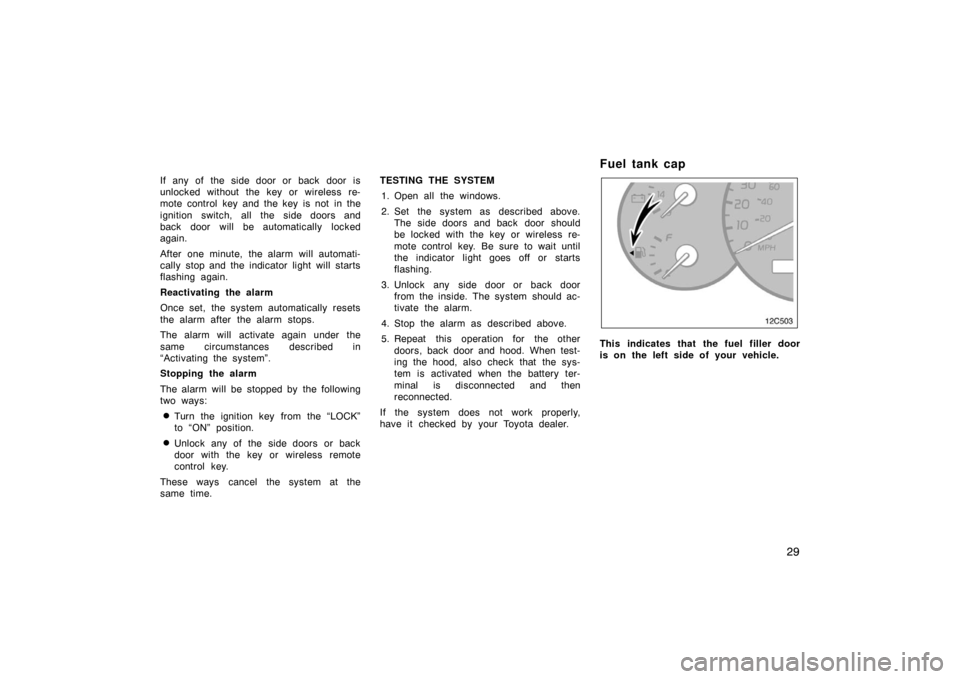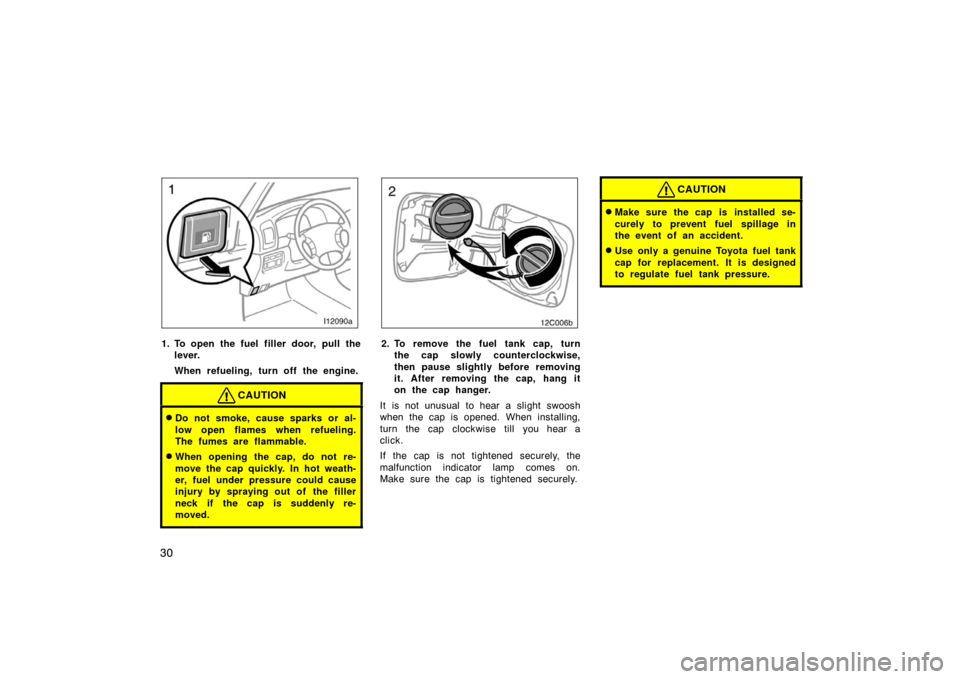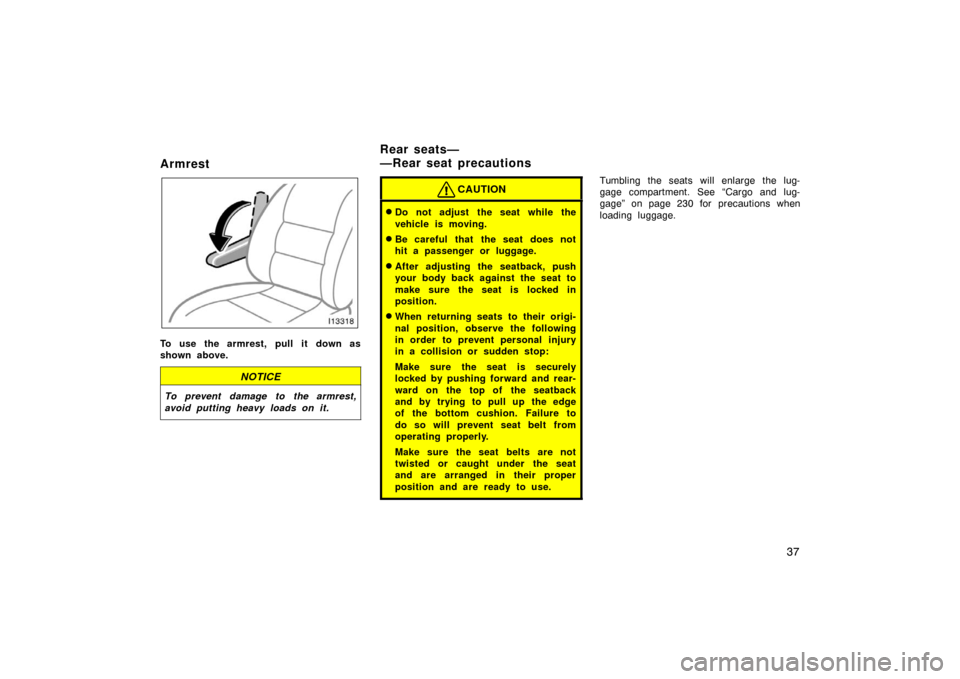Page 35 of 351
25
Back door
LOCKING AND UNLOCKING WITH KEY
Insert the key into the key hole and
turn it.
To lock: Turn the key clockwise.
To unlock: Turn the key counterclockwise.
All the doors lock and unlock simulta-
neously with back door.
Operating the power door lock switch si-
multaneously locks or unlocks all the side
doors and the back door. (See “—Locking
and unlocking doors” on page 14 and
“Side doors” on page 18.)
To open the back door, pull the lock re-
lease lever.Pull the handle toward you and pull
down the lower side of the back door.
When closing the back door, make sure
it is fully closed.
See “Cargo and luggage” on page 230 for
precautions when loading luggage.LOCKING AND UNLOCKING FROM IN-
SIDE
To lock: Push the knob.
To unlock: Pull the knob.
Operating the power door lock switch si-
multaneously locks or unlocks all the side
doors and the back door. (See “Side
doors” on page 18.)
Page 36 of 351
26
Push the handle and push down the
lower side of the back door.
When closing the back door, make sure
it is fully closed.
See “Cargo and luggage” on page 230 for
precautions when loading luggage.
CAUTION
�Keep the back door closed while
driving. This not only keeps the
luggage from being thrown out but
also prevents exhaust gases from
entering the vehicle.
�If the open back door hides the
stop and tail lights, rear turn signal
lights or rear retro reflectors while
you are parked, other road users
must be warned of the presence of
your vehicle by a warning triangle
or other device.
BACK DOOR CHILD�PROTECTOR
Move the lock lever to the “LOCK”
position as shown on the label.
When the child−protector is locked, you
cannot open the back door by the inside
door handle. We recommend using this
feature whenever small children are in the
vehicle.
Page 37 of 351
27
CAUTION
Before driving, be sure that the back
door is closed and locked, especially
when small children are in the ve-
hicle. Along with the proper use of
seat belts, locking the doors helps
prevent the driver and passengers
from being thrown out from the ve-
hicle during an accident. It also helps
prevent the doors from being opened
unintentionally.
Hood
To open the hood:1. Pull the hood lock release lever. The hood will spring up slightly.
CAUTION
Before driving, be sure that the hood
is closed and securely locked. Other-
wise, the hood may open unexpected-
ly while driving and an accident may
occur.
2. In front of the vehicle, pull up theauxiliary catch l ever and lift the
hood.
Before closing the hood, check to see that
you have not forgotten any tools, rags,
etc. Then lower the hood and make sure
it locks into place. If necessary, press
down gently on the front edge to lock it.
Page 38 of 351

28
Theft deterrent system
To deter vehicle theft, the system is
designed to sound an alarm if any of
the side doors, back door or hood is
forcibly unlocked or opened or the bat-
tery terminal is disconnected and then
reconnected when the vehicle is locked.
The alarm blows the horn intermittently
and flashes the headlights, tail lights and
other exterior lights.SETTING THE SYSTEM1. Turn the ignition key to the “LOCK” position and remove it.
The indicator light will start flashing when
the key is removed from the ignition
switch. (See “Engine immobilizer system”
on page 12 for details.)
2. Have all passengers get out of the vehicle.
3. Close and lock all the side doors, back door and hood.
The indicator light will come on when all
the side doors, back door and hood are
closed and locked. The system will automatically be set after
30 seconds. When the system is set, the
indicator light will start flashing again.
4. After making sure the indicator light starts flashing, you may leave the ve-
hicle.
Never leave anyone in the vehicle when
you set the system, because unlocking
from the inside will activate the system.
WHEN THE SYSTEM IS SET
Activating the system
The system will sound the alarm under
the following conditions:�If any of the side doors is unlocked or
opened without the key or wireless re-
mote control key, or if the back door
or hood is forcibly opened
�If the battery terminal is disconnected
and then reconnected
The indicator light will come on when the
system is activated.
Page 39 of 351

29
If any of the side door or back door is
unlocked without the key or wireless re-
mote control key and the key is not in the
ignition switch, all the side doors and
back door will be automatically locked
again.
After one minute, the alarm will automati-
cally stop and the indicator light will starts
flashing again.
Reactivating the alarm
Once set, the system automatically resets
the alarm after the alarm stops.
The alarm will activate again under the
same circumstances described in
“Activating the system”.
Stopping the alarm
The alarm will be stopped by the following
two ways:
�Turn the ignition key from the “LOCK”
to “ON” position.
�Unlock any of the side doors or back
door with the key or wireless remote
control key.
These ways cancel the system at the
same time. TESTING THE SYSTEM
1. Open all the windows.
2. Set the system as described above. The side doors and back door should
be locked with the key or wireless re-
mote control key. Be sure to wait until
the indicator light goes off or starts
flashing.
3. Unlock any side door or back door from the inside. The system should ac-
tivate the alarm.
4. Stop the alarm as described above.
5. Repeat this operation for the other doors, back door and hood. When test-
ing the hood, also check that the sys-
tem is activated when the battery ter-
minal is disconnected and then
reconnected.
If the system does not work properly,
have it checked by your Toyota dealer.
Fuel tank cap
12C503
This indicates that the fuel filler door
is on the left side of your vehicle.
Page 40 of 351

30
1. To open the fuel filler door, pull thelever.
When refueling, turn off the engine.
CAUTION
�Do not smoke, cause sparks or al-
low open flames when refueling.
The fumes are flammable.
�When opening the cap, do not re-
move the cap quickly. In hot weath-
er, fuel under pressure could cause
injury by spraying out of the filler
neck if the cap is suddenly re-
moved.
12C006b
2. To remove the fuel tank cap, turnthe cap slowly counterclockwise,
then pause slightly before removing
it. After removing the cap, hang it
on the cap hanger.
It is not unusual to hear a slight swoosh
when the cap is opened. When installing,
turn the cap clockwise till you hear a
click.
If the cap is not tightened securely, the
malfunction indicator lamp comes on.
Make sure the cap is tightened securely.
CAUTION
�Make sure the cap is installed se-
curely to prevent fuel sp illage in
the event of an accident.
�Use only a genuine Toyota fuel tank
cap for replacement. It is designed
to regulate fuel tank pressure.
Page 47 of 351

37
Armrest
To use the armrest, pull it down as
shown above.
NOTICE
To prevent damage to the armrest,
avoid putting heavy loads on it.
CAUTION
�Do not adjust the seat while the
vehicle is moving.
�Be careful that the seat does not
hit a passenger or luggage.
�After adjusting the seatback, push
your body back against the seat to
make sure the seat is locked in
position.
�When returning seats to their origi-
nal position, observe the following
in order to prevent personal injury
in a collision or sudden stop:
Make sure the seat is securely
locked by pushing forward and rear-
ward on the top of the seatback
and by trying to pull up the edge
of the bottom cushion. Failure to
do so will prevent seat belt from
operating properly.
Make sure the seat belts are not
twisted or caught under the seat
and are arranged in their proper
position and are ready to use.
Tumbling the seats will enlarge the lug-
gage compartment. See “Cargo and lug-
gage” on page 230 for precautions when
loading luggage.
Rear seats—
—Rear seat precautions
Page 48 of 351

38I13220c
SEATBACK ANGLE ADJUSTING LEVER
Lean forward and pull the lever toward
you. Then lean back to the desired
angle and release the lever.
CAUTION
�Avoid reclining the seatback any
more than needed. The seat belts
provide maximum protection in a
frontal or rear collision when the
second seat passengers are sitting
up straight and well back in the
seats. If you are reclined, the lap
belt may slide past your hips and
apply restraint forces directly to the
abdomen or your neck may contact
the shoulder belt. In the event of a
frontal collision, the more the seat
is reclined, the greater the risk of
death or personal injury.
�Do not adjust the seat while the
vehicle is moving.
�After adjusting the seatback, push
your body back against the seat to
make sure the seat is locked in
position.
For easy access to the third seat:
1. Lower the head restraint to the low- est position.
2. Push the seatback angle adjusting lever and pull the seat cushion lock
release lever or pull the strap.
After passengers are in, return the seat
until it locks.
—Adjusting second seats —Moving second seat for
third seat entry